It was fantastic to see how many of you enjoyed our live stream talk about the wild birds around the park. If you missed it, you can catch up HERE. It is feeling so spring-like outside at the moment I thought it would be great to talk about some of the wild birds to look out for here from March through to August.
A lot of wild birds use the Park in the Spring and Summer. This is either to take advantage of the free food on offer or for a safe place to raise their families. Over the years I have found lots of species nesting here, and record which nests I see for the BTO’s Nest Record Scheme. If you would like to find out more about the bird nests I have found at the Park see my previous blog (and cute baby bird photos!) HERE.
Birds that usually breed each year at Wingham Wildlife Park
The breeding birds are the native birds that you are most likely to see on your visit to Wingham Wildlife Park. I will point out the best places to spot them, but most of the time I identify them by their songs as a lot of songbirds I often hear singing or calling rather than spotting them visually.
For the species of birds which you can often hear at the Park I will include a website link where you can go and listen to the song. Please note that it is not a good idea to play these songs aloud in the field around the birds, as they may abandon their nesting duties to investigate what they think is a potential rival in their territory!
Robin
The bravest wild bird you are likely to see at Wingham Wildlife Park! It often feels like each enclosure has its own Robin following us about as we sweep, dig, and work around our enclosures. Hoping of course that we will unearth a tasty worm or bug for them to pounce on. If you have bought some tasty meal worms from our shop, they will happily come and take them off your hands.
It always surprises me where Robins choose to build their nests. They are great at finding little crevices to raise their families. We once had one build a nest in an old work boot in our workshop, and a one-legged Robin built its nest in a tiny little gap at the bottom of our freezer. There are approximately 7.4 million Robin territories in the UK each summer and their cup nest is usually built close to the ground and is made with dead leaves and moss.
Listen to Robin song HERE.
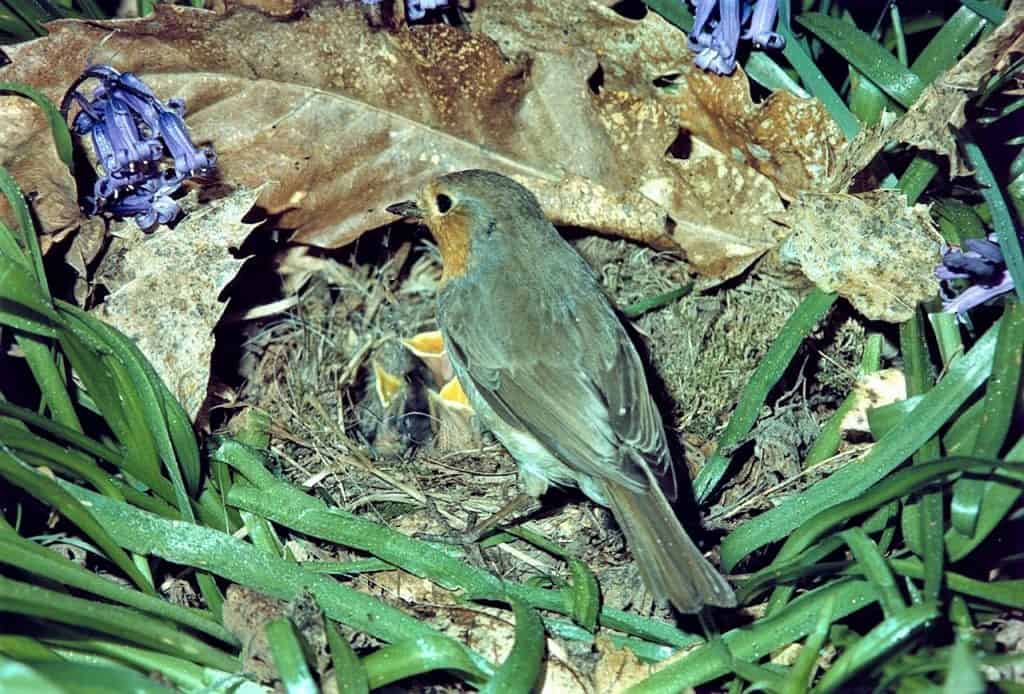
House Sparrow
It’s brilliant to see House Sparrows, which are a Red Listed species, thriving at the Park. Around 5.3 million pairs breed in the UK each year. I don’t see House Sparrows nests very often as they are usually tucked away in holes and crevices within buildings. They are also the birds that have taken up residence in most of our wooden bird nest boxes that you may see on some of our buildings. But here at the Park they also build a lot of free-standing nests in our animal enclosures and bushes.
The nests are woven together with grass, other vegetation, and any titbits they find… I’ve even found Porcupine quills and colourful Macaw feathers woven into their nests! This shows their close relationship to the weaver birds which build similar nests in the tropics. They line the nest with feathers, and I love watching the adults trying to capture a rogue feather, chasing it along. Quite entertaining!
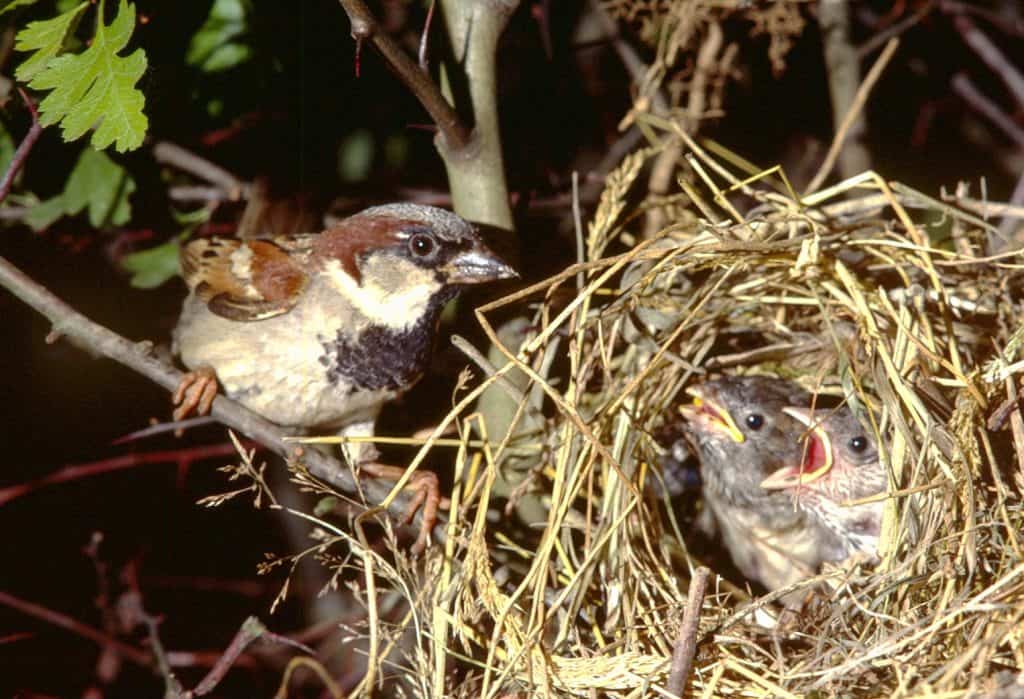
Dunnock
These charming little birds are often overlooked and dismissed as other similar species. We have a few different territories around the Park. I usually hear them in each corner of the park singing their squeaky song, and often spot them feeding in the Emu and Goat paddocks. They also arrive when we feed the Cranes to pinch the meal worms from their food tray.
An Amber Listed species with an estimated 2.5 million territories throughout Britain in the Summer which has seen recent population declines. Their eggs are bright blue, and again they make a well concealed cupped nest out of twigs and moss which is lined with wool or feathers.
Dunnocks are unusual in their breeding behaviour as they do not form traditional pairs like most birds do. Famously, they breed in groups of up to three males and three females, with two males and females being usual.
Listen to Dunnock song HERE.
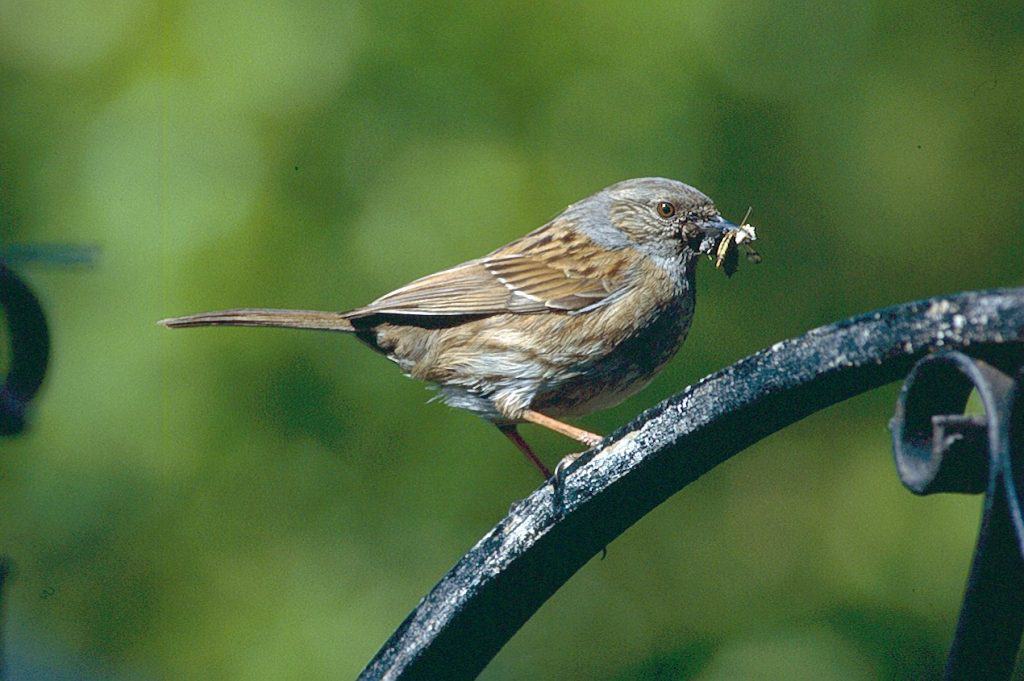
Blackbird
Blackbird nests are usually quite hard to find as they are often very secretive. Here at the Park though they seem to nest out in the open in our animal enclosures. They build a large cup nest using grass, straw and twigs which is plastered inside with mud and lined with fine grass. Their eggs are also blue and they will often use the same nest to raise multiple broods. I once found a Blackbird nesting next to a busy bin successfully!
You can spot these birds in every part of the Park, but they especially like the grassy areas where they can find tasty worms. There are an estimated 5.1 million pairs of Blackbirds breeding in the UK every Summer. They are partial migrants though, with some birds joining us from the continent in the winter. In March I often see the resident Blackbirds squabbling with these newcomers as they start to set up their territories.
Listen to Blackbird song HERE.
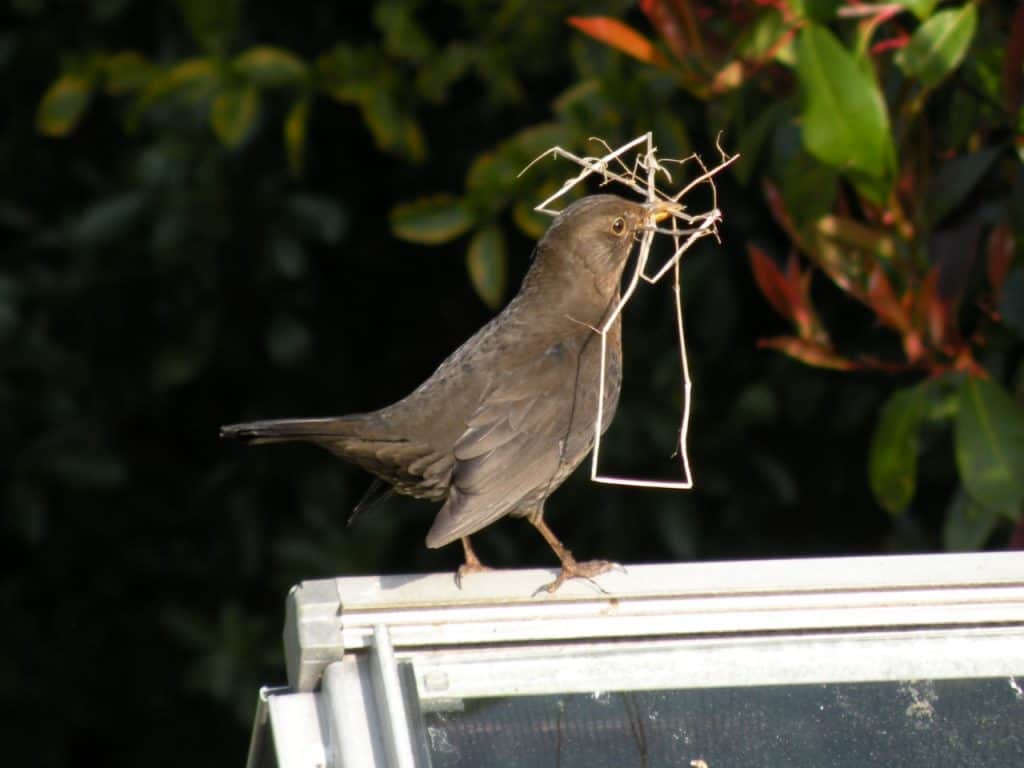
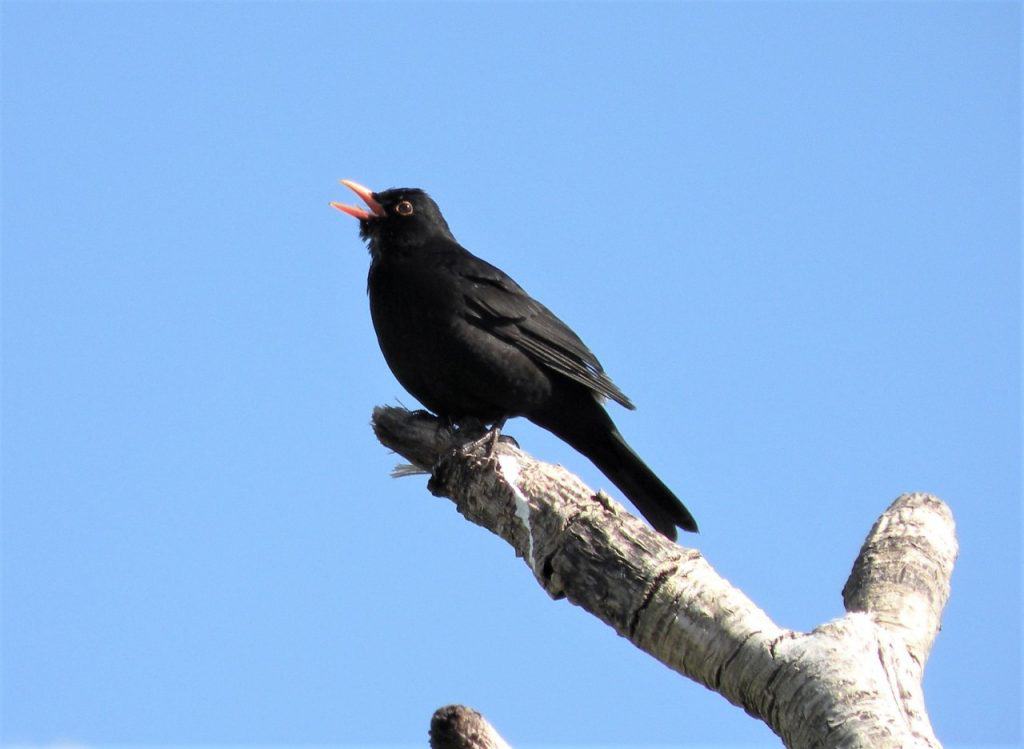
Mistle Thrush
It is so exciting to have this Red Listed bird breeding at the Park. In the UK there are around 165 thousand territories each summer and at least one pair breed here every year, but I am certain it could be as many as three! They are one of our earlier breeders with eggs often laid in February. The nest is quite large and untidy and I often find bits of plastic and feathers woven into it. It is made from mud sandwiched between grasses. I love hearing their mournful song throughout the day in spring. They sound similar to Song Thrushes but almost seem like they have forgotten the words. This is another Thrush that lays blue eggs.
Listen to Mistle Thrush song HERE.
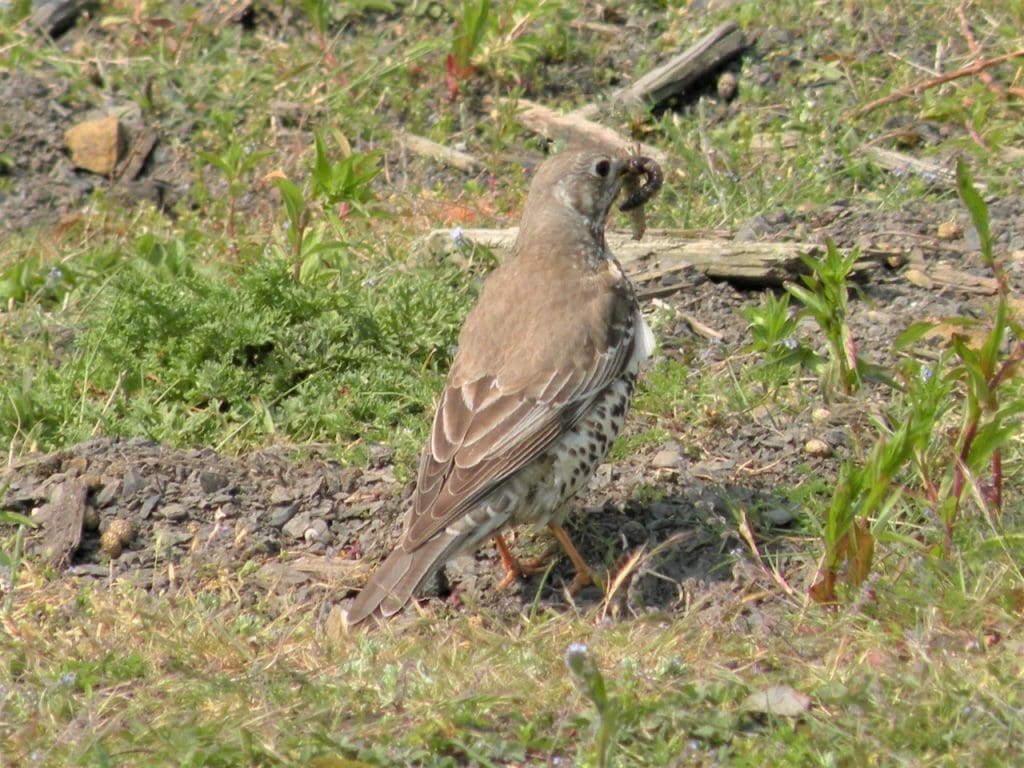
Song Thrush
Song Thrushes breed here every year and we seem to have a male singing in each corner of the Park. They appear to like looking for earthworms on the grass over at our Ring-tailed Lemur enclosure. There are an estimated 1.3 million territories each summer in the UK, but they have had recent population declines. Their nest is similar to the Blackbird and Mistle Thrush. They also have blue eggs, but the grass and moss cup is cemented and thickly lined with mud which is very distinctive.
Their song is unmistakable once you know what to look out for. It is all about repetitions! The males sing particular phrases of their song, from a huge repertoire, but distinctively they repeat the same phrase at least twice, but often four or five times or more. A quick pause, then it is the same with a different phrase. Just fantastic to watch them in action. Each individual has about 100 phrases to choose from, and they can even sing other species songs as they are quite adept at mimicry.
Listen to Song Thrush song HERE.
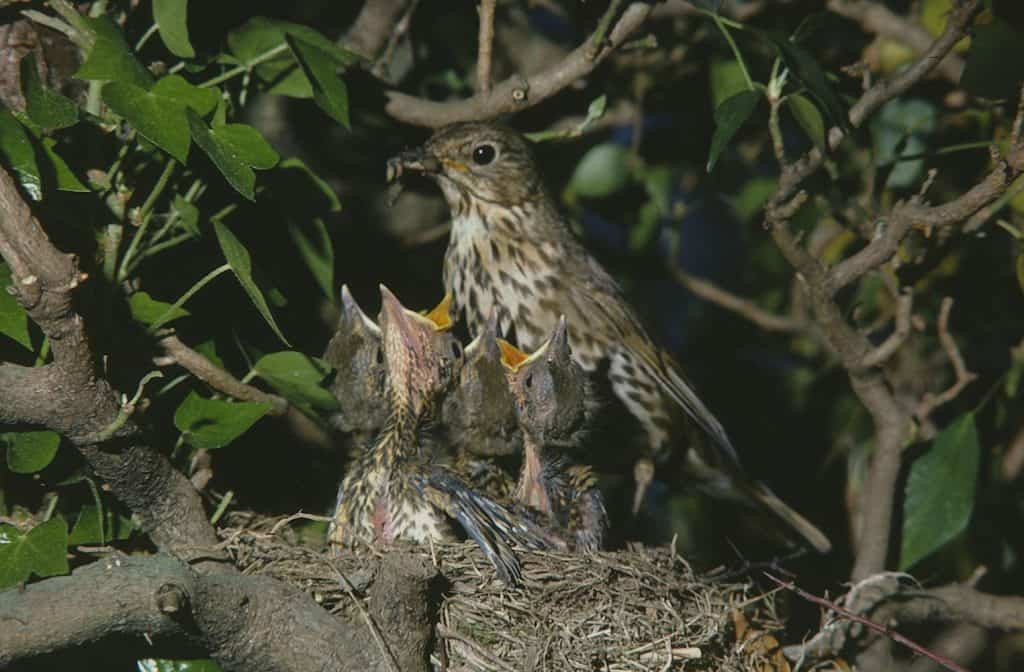
Blue Tit
There are an estimated 3.4 million pairs of Blue Tit in the UK each year. Here at the Park, they occasionally use the nest boxes that we have installed. I have also seen them nesting in natural holes in the trees. I often spot them feeding in the trees between the Flamingo enclosure and the Reptile House. They regularly come down to the bird feeders as well.
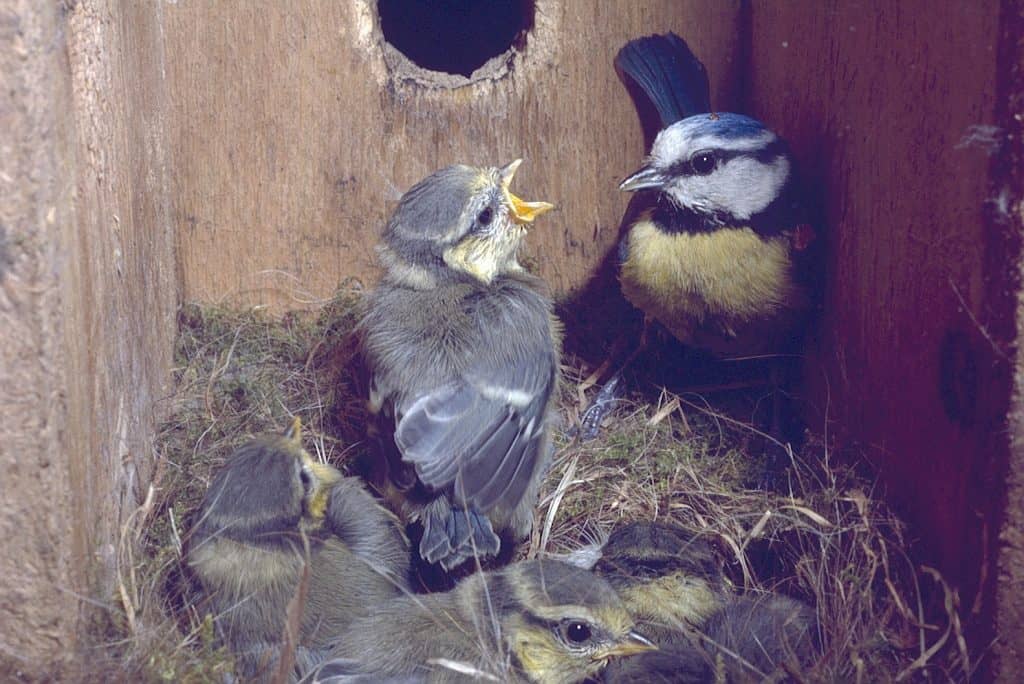
Chaffinch
I have never found an active Chaffinch nest here. However, every year we see fledged young hopping about being fed by their parents. Chaffinches can be seen in most parts of the Park, but I often hear and see the males singing in the trees around the Tapirs and on the lake by the big cat enclosures. Approximately 5.1 million pairs nest each summer in the UK.
Nest building does not usually start until April or even early May and it is the female that builds a cup-shape nest in the forks of trees and hedges. The nest is made from spider’s webs, moss and grass and is lined with feathers. I saw a female Chaffinch this year collecting spider webs from our office door, brilliant to watch! The nests are well camouflaged and so I usually only see the nests in the trees after the breeding season, once the leaves have dropped.
Listen to Chaffinch song HERE.
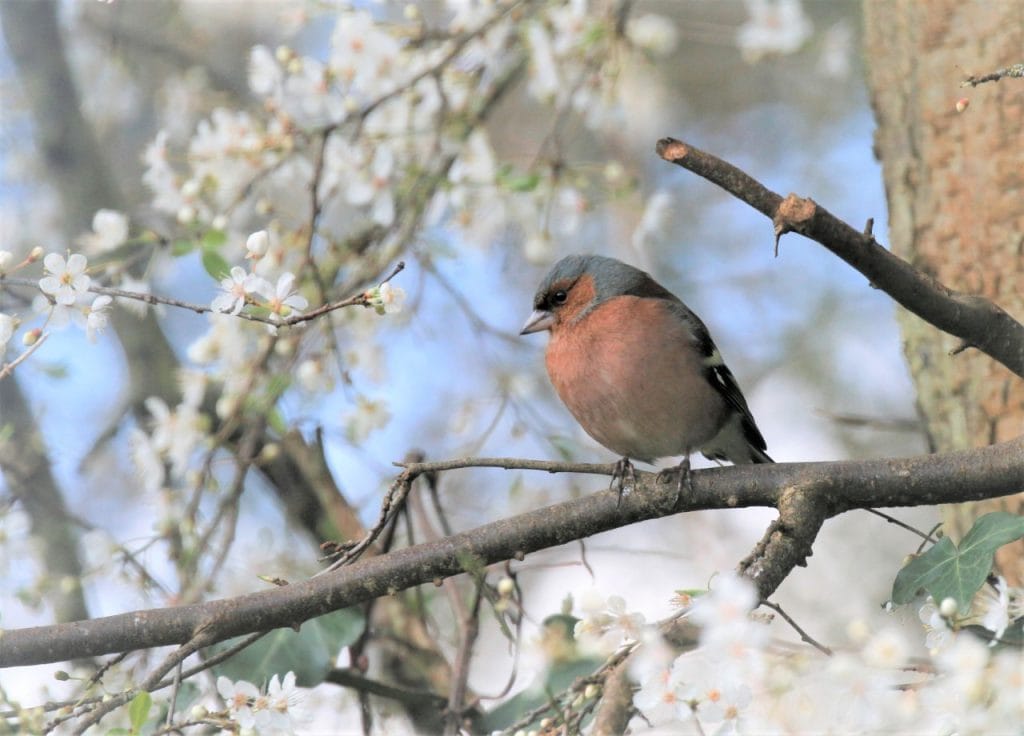
Goldfinch
Goldfinch nests are very similar to Chaffinch nests but as well as nesting in the trees, I have also found their little nests in the bamboo that grows around the Park. There are around 1.7 million pairs of Goldfinch breed each summer in Britain. Listen out for them whirring away at the tops of the trees, especially around our Ring-tailed Lemur enclosure.
Listen to Goldfinch song HERE.
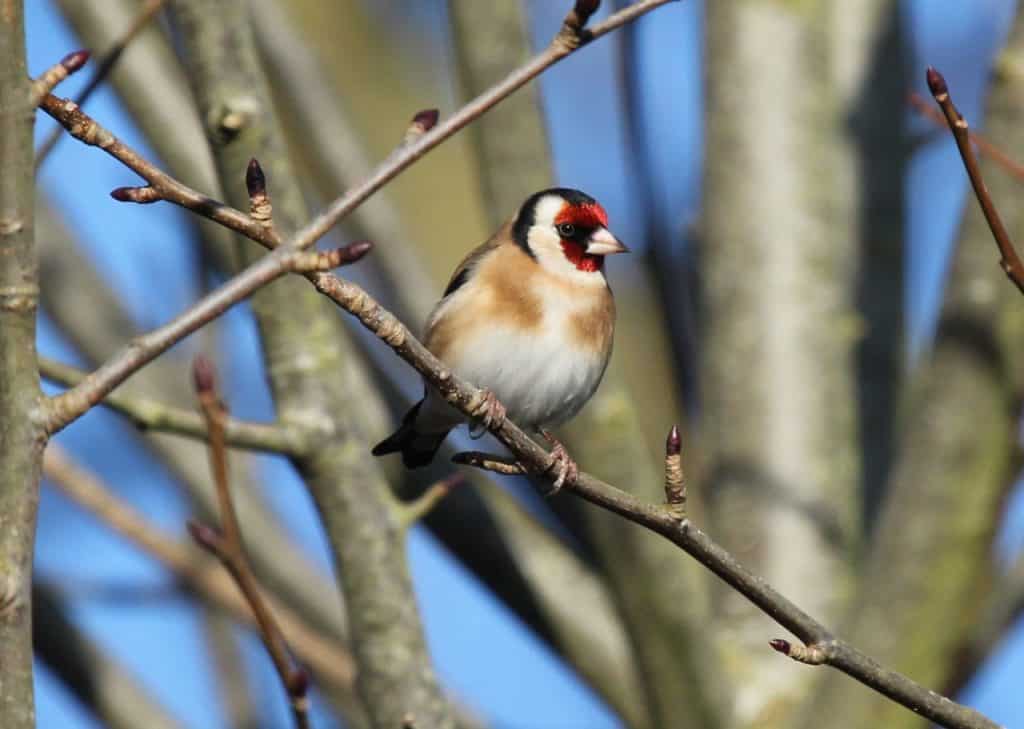
Collared Doves and Woodpigeons
Both nest at the Park each year and both make a rather precarious nest of just a few twigs thrown together in the trees, and occasionally on some of our buildings in the Collard Dove’s case. Both species can be seen throughout the Park, and a great way to tell them apart is by listening to their calls. This video from the BTO has some great tips on how to recognise them, watch it HERE.
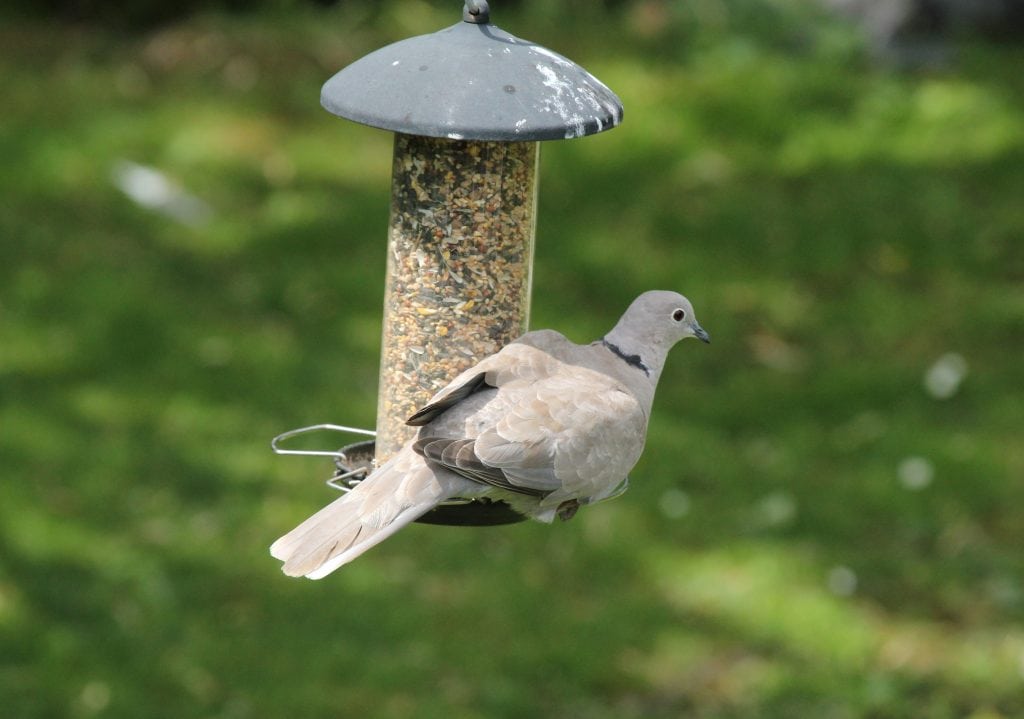
Whilst Woodpigeons historically were a woodland species, they have become an abundant species in the UK. They have now expanded their range to more open country, parks, and gardens, with 5.2 million pairs estimated to breed each summer in the UK. Collared Doves however, only bred for the first time in Britain in 1955 after spreading from the far east. Now an estimated 810 thousand Pairs breed each summer.
Mallard Duck
Mallard ducks do quite well at Wingham Wildlife Park. Here in the UK there are an estimated 103 thousand pairs here in the summer. They often make good use of the food for our own Ducks and Geese on the Lake. As I type there are Ducklings wandering around the Park following their mother in search of food and often will happily gobble up any visitor feed if you have purchased it from the shop.
Females are plain brown and the males are unmistakable with their bright green heads. They look so different from each other that they were originally thought to be separate species! The female builds a nest from leaves and grass and lines it with down feathers plucked from her own breast. Eggs are laid between mid-March and the end of July.
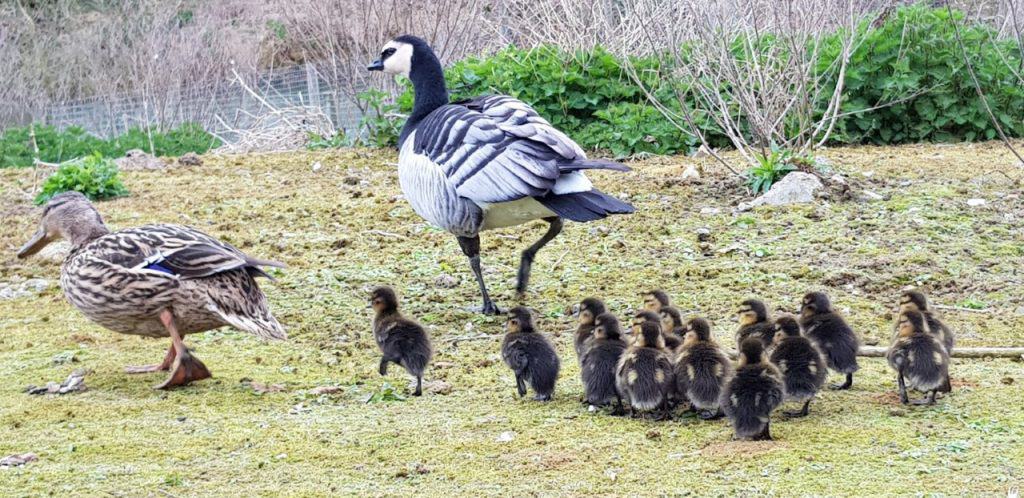
Moorhen
We usually have a couple of Moorhens on the large lake at the top of the Park However, I often see them nesting in our Pelican and Flamingo enclosures as well. There are 210 thousand Territories in the UK each summer and their nest is a simple one built out of vegetation from the surrounding water. The Moorhen is one of only two British birds which breed co-operatively, with older young helping their parents raise subsequent chicks! Their chicks are so ugly-cute and they wave their little wings from side to side when they ask for food. Adorable.
Pied Wagtail
Approximately 550 thousand pairs breed the UK each year and here at the Park we tend to have at least two pairs. One pair usually nests in our back of house areas, and once nested in an old tractor. The other pair often nest somewhere around the Red Panda enclosure.
Pied Wagtails (Motacilla alba yarrellii) are actually a subspecies of White Wagtail. Look out for them on the green next to the Penguin enclosure. This is where they collect nesting material, and later on food for their young. The female builds the cup-shaped nest from grass and lines it with hair, wool, or feathers. Listen out for their distinctive calls as they fly overhead, and of course watch out for that famous tail wag when you spot them on the ground.
Listen to Pied Wagtail calls HERE.
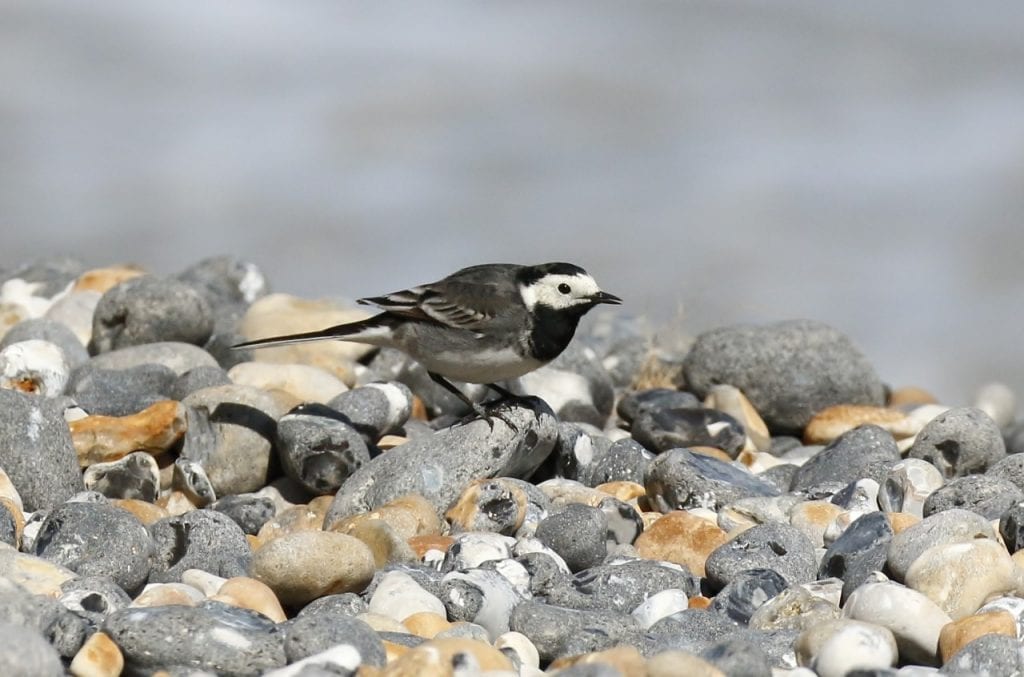
Starling
Starlings build their nests in the roof tops of some of our buildings and will also use old Woodpecker holes in the trees. Another Red Listed species, there are around 1.8 million pairs that breed each summer in the UK. Look out for them on the electrical wires around the Park, the male’s song is very impressive. To me it sounds like the are beatboxing and I have heard starlings mimic many different species, as well as other sounds like car alarms! In the breeding season, males have a blue colour on the base of their bill whilst females bill colour is pink at the base!
Listen to Starling song HERE.
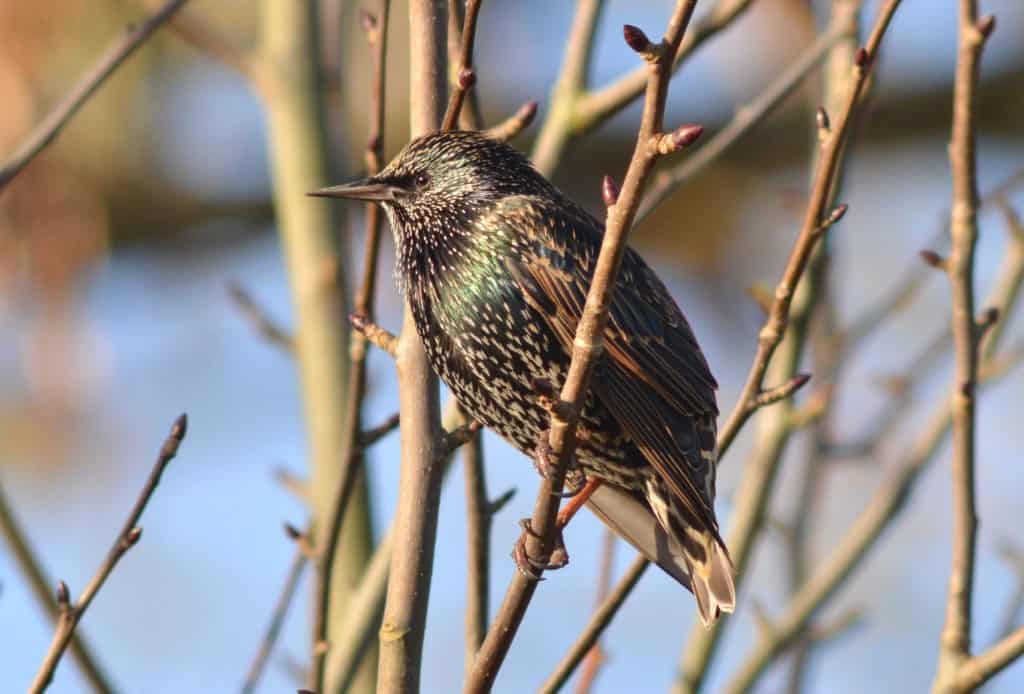
Wren
Whilst Wrens, like Robins, sing throughout the winter, come spring they knock it up a few notches. Definitely the loudest wild bird song you will hear on your visit, it is astounding how loud these tiny birds are! I can usually hear Wrens singing in all parts of the Park. Plus, if I am lucky I will get a glimpse of one flitting across in front of me or singing perched in a bush. They often wag their tails from side to side as they sing and display which I find hilarious!
There are around 11 million territories in the UK each year. They seem to build their nests almost anywhere; in buildings, in vegetation, up high, down low and they will even use open-fronted nest boxes too. The males construct several globe-shaped nests using old leaves, grass, and moss. When the female has chosen a nest, she finishes it off by lining it with feathers, leaving just a little hole for an entrance.
Listen to Wren song HERE.
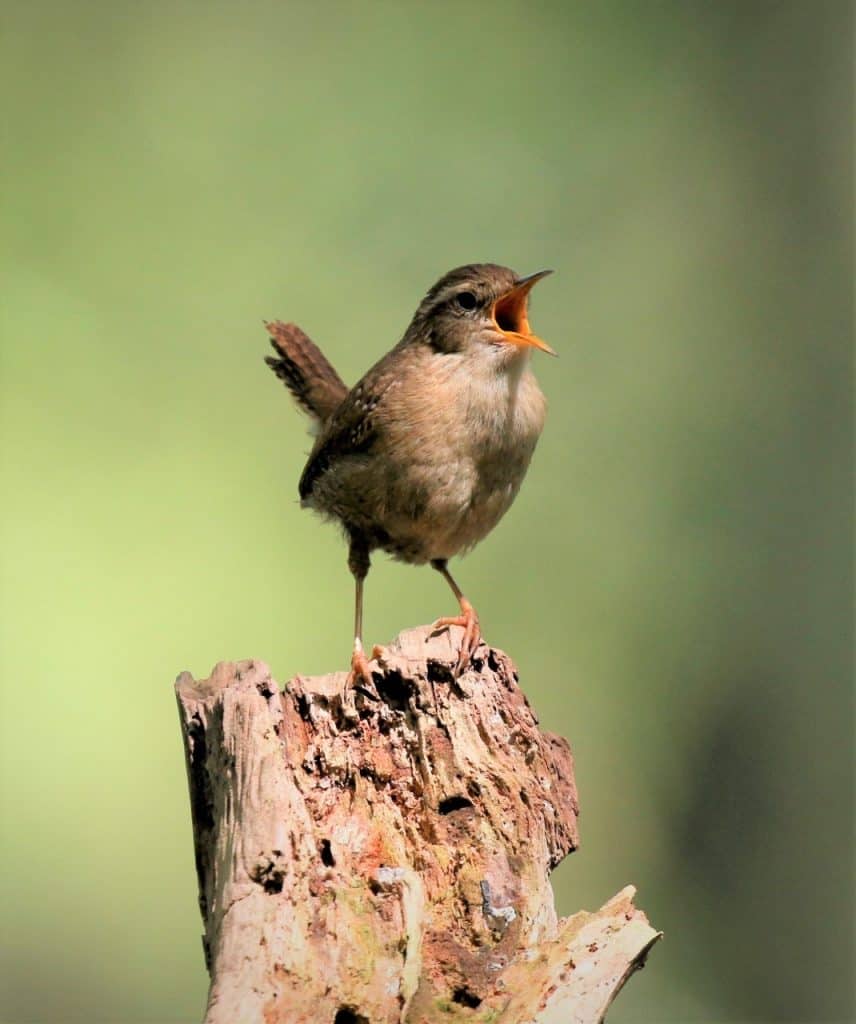
Other birds that you might see at Wingham Wildlife Park
Green Woodpeckers have nested at the Park in the past. However, I have not seen them nesting for a number of years now. Although you can occasionally hear their yaffling calls as they fly by (listen to them HERE).
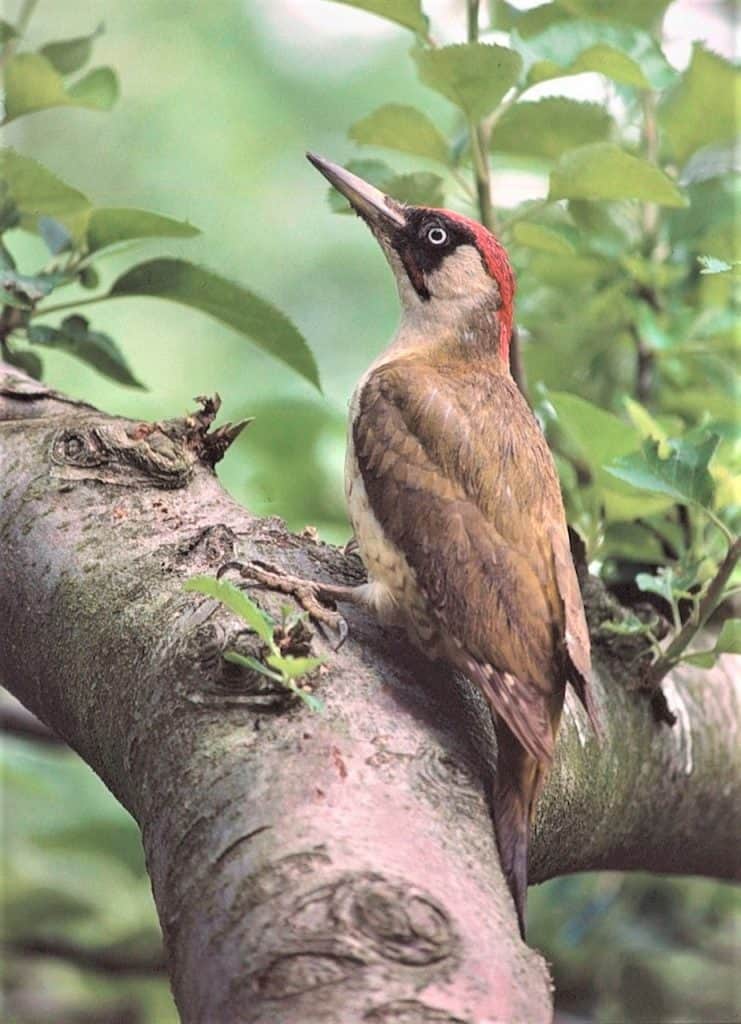
Another interesting species that have nested at the Park a few times are Spotted Flycatchers. This Red Listed species is really secretive and only 42 thousand pairs are thought to breed each year in the UK. They build a cup nest out of grass, twigs and roots which is lined with fine feathers, hair, or dead leaves. They migrate to the UK to breed from Africa, before heading back again in August.
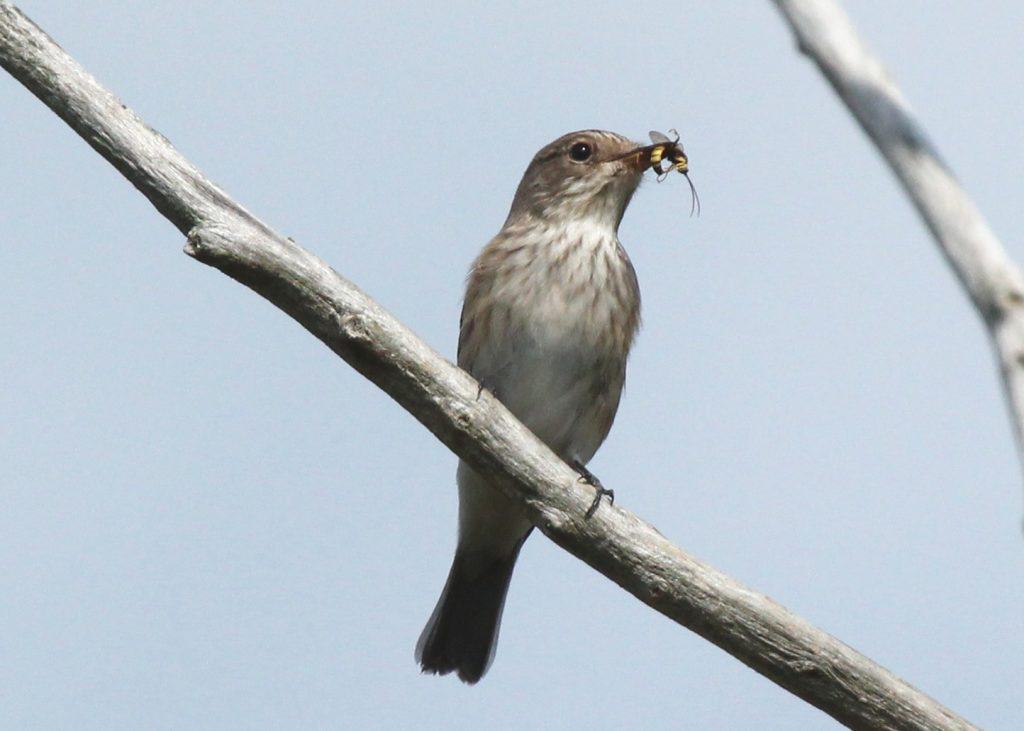
Whilst I have never found Great Tits nesting at the Park, they can often be seen in the similar haunts of the Blue Tits down by the Flamingo Enclosure. Greenfinches can sometimes be heard whirring away in that area too. Although I am not sure if they have ever nested there. Listen to their characteristic calls HERE.
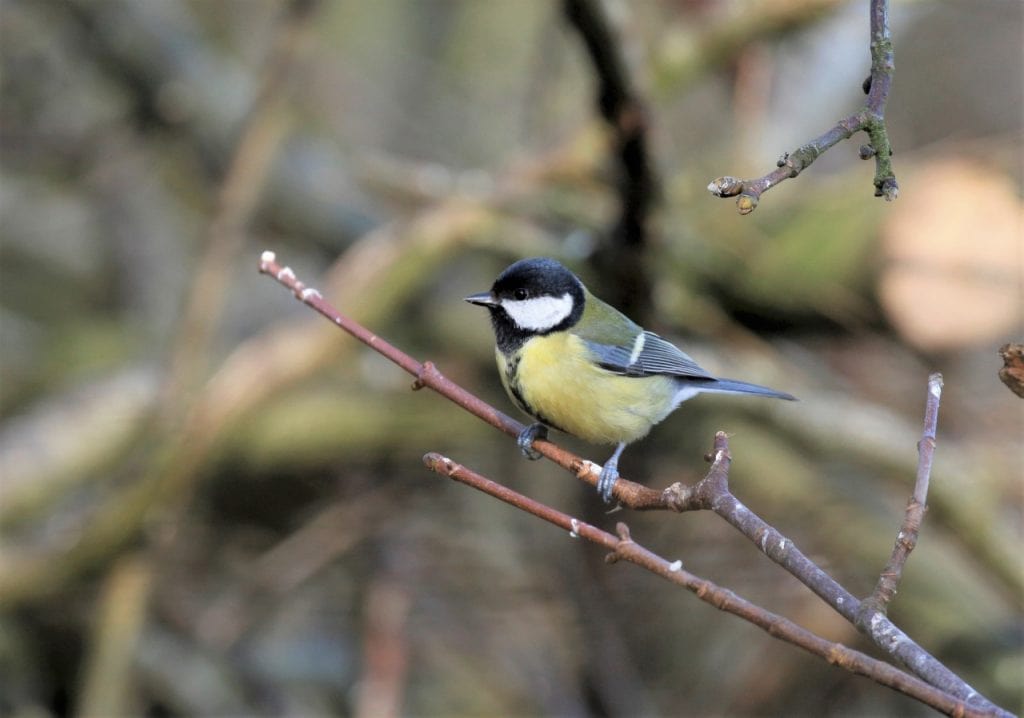
The Park does well for birds of prey and Buzzards can often be seen soaring above the Park. Our own birds usually spot these before we do! If I see one of our birds gazing up at the sky there is usually a Buzzard up there and our Parrots announce their presence with loud alarm calls!
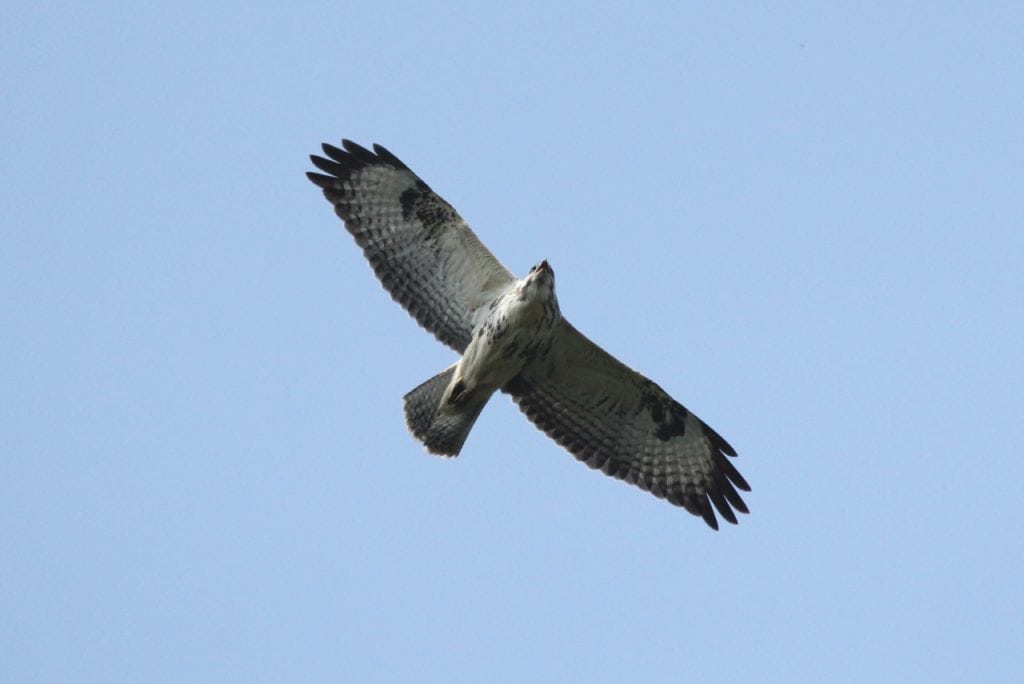
Other birds of prey that can be seen here in spring include Kestrels, which hover on the outskirts of the Park looking for rodents, and Sparrowhawks which take full advantage of our large wild bird population. They have even used me before as a barrier to launch a surprise attack.
At night Little Owls can be heard calling around the Park, and one year I heard them in the trees on the Lake where our Storks nest. I’m dead certain they bred there or nearby but I never did find the nest.
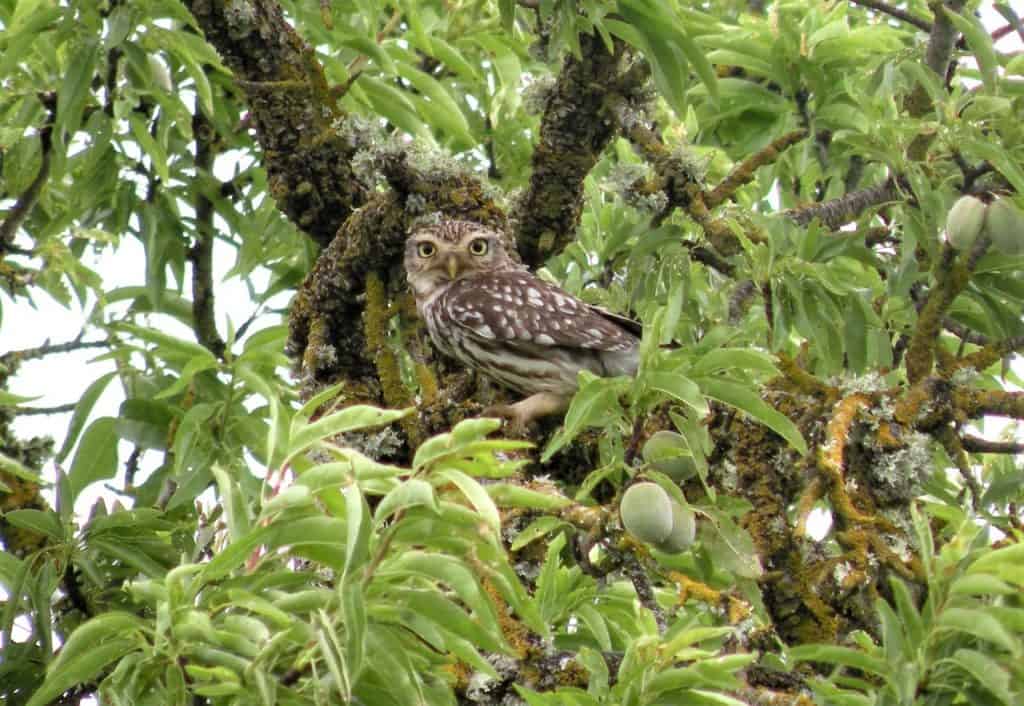
The Park is also frequented by Corvids such as Carrion Crows, Magpies, Rooks and Jackdaws. Very occasionally I will spot a Jay and a couple of times even a Raven which are slowly starting to spread out into Kent again.
At the start of spring and end of summer you can often hear Chiffchaffs as they pass through on migration from Africa. Other migrants such as House Martins, Swallows, and Swifts can be seen flying overhead in the summer as well. The first two have bred here at the Park in the past, and often come down on the lake to take a drink.
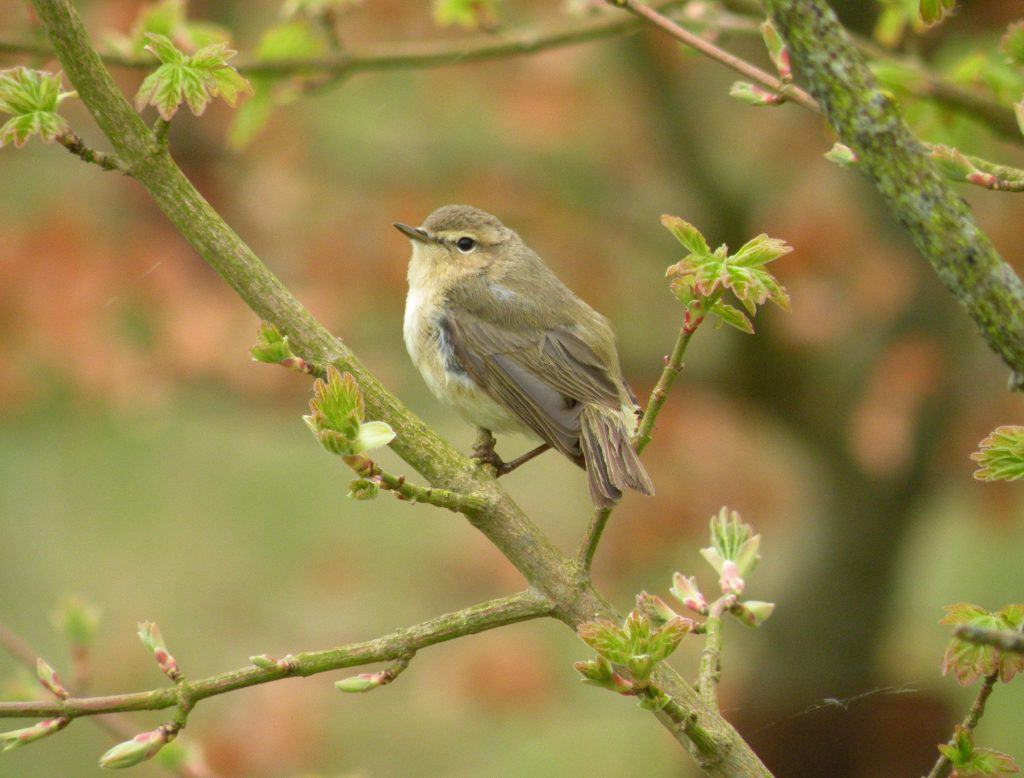
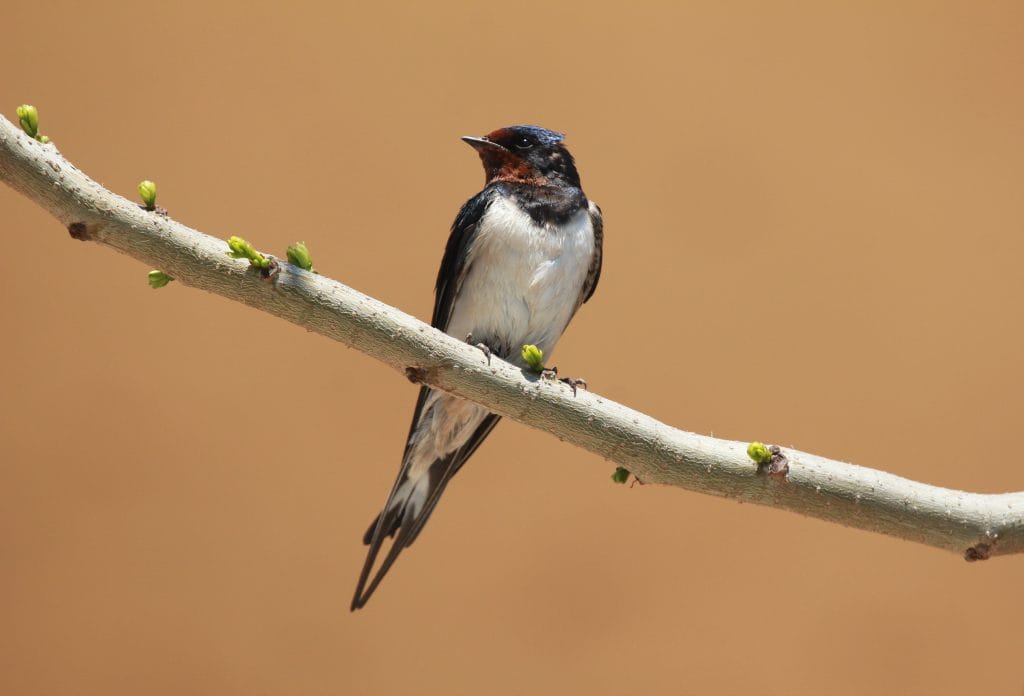
The lake is also a good place to spot the occasional Coot and Grey Wagtail. They also like to hang out in the Tapir paddock when they are around. At least one pair of Herring Gulls hang around during the breeding season, but I am not sure if they actually nest in the Park itself. Often considered a pest, Herring Gulls are actually a Red Listed species with a recent population decline in the UK.
And finally, the last bird that you might be lucky enough to see here at the Park is an introduced species to the UK from escapees, the Ring-necked Parakeet. Listen out for their calls HERE as they fly over.
Have you spotted a bird that is not on this list? Well we would love to hear from you! You can post your photos on our Facebook page or tag us in your social media posts!
Help with Identification
If you would like to learn more about bird identification I can recommend a couple of books. Every birder’s bible is the “Collins Bird Guide: The Most Complete Guide to the Birds of Britain and Europe“ by Lars Svensson.
If you are interested in bird nests and nest recording, I use “A Field Guide to Monitoring Nests” by James, Ferguson-Lees, Richard Castell and Dave Leech.
But the best way to increase your skills is by going outside and finding birds and trying to identify what you see. I found it helpful to be with other birders who could confirm what I thought or point out things I would have missed! I started off by joining guided nature walks by Sandwich Bay Bird Observatory. These are usually held every Sunday at 9am at £3 per person. If you would like to join you can find out more details HERE.
Figures used in my blog are from the BTO’s bird facts feature where you can look up any species that’s been recorded in the UK and see all sorts of nerdy facts about them. Check it out HERE.
And finally a huge thank you to my friend John Buckingham for letting me use his photos in this blog. John has travelled the world birding and also runs courses and lectures to improve your ID skills. Keep an eye out for them over at the Sandwich Bay Bird Observatory website HERE.
Happy birding!


